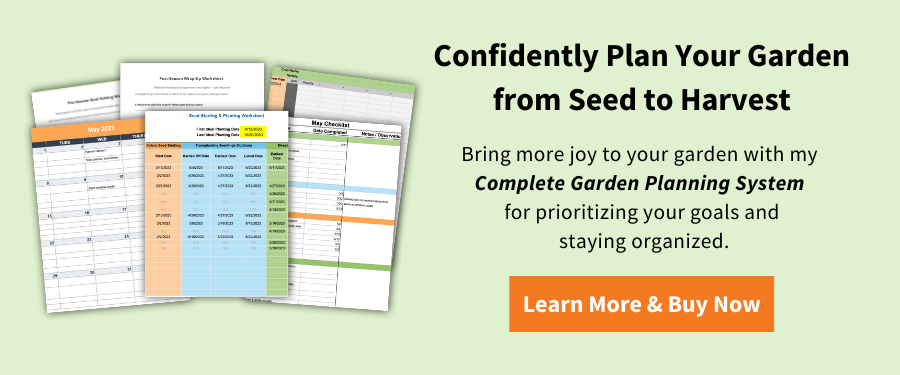Growing and Harvesting Beets Year-Round
Would you like to grow and harvest beets year-round? Follow this guide for the best way to grow beets in all seasons, companion planting tips, and more.


This page may contain affiliate links. Please read my disclosure for more info.
About Growing Beets
Beets are an annual crop that is in the same plant family as spinach and chard. Interestingly, they are also related to common edible weeds such as goosefoot, lamb’s quarters, and pigweed.
This crop yields a beautiful two-for-one harvest: Nutritious greens as well as nutrient dense roots. This makes them an efficient way to grow more produce with less work and with less space!
A cool-season vegetable, they grow best in the spring and fall seasons, but can be nurtured through winter and summer as well with a little extra care.
They prefer full sun or partial shade with at least four hours of sun each day.
However, if you have a shady yard, don’t despair! I was able to grow 80 pounds of vegetables by focusing on shade-friendly root and leaf crops (like beets and carrots) in my forest garden.
Rich soil is one of the more important components of growing beets successfully. Let’s take a look at a few more details for preparing your garden beds.
Preparing the Soil
Beets require a well-prepared bed with fertile soil. Two weeks before planting I loosen the soil about six to eight inches deep with a digging fork in my no-till garden. Then, I mix in worm castings and/or herbicide-free aged manure.
Read more:


A variety of beets from the garden…love the colors!
Choosing a Beet Variety
Beets varieties range from solid colors to striped interiors, colors ranging from pink to red to orange, and shapes from round to cylindrical.
Here are some beet varieties that I enjoy growing from Botanical Interests Seeds:
- ‘Chioggia‘: This pink-red Italian variety has a mild flavor and a fun, candy-striped interior.
- ‘Detroit Dark Red‘: Dark red beets are excellent for winter storage, canning, and pickling.
- ‘Golden Boy‘: These beautiful, golden beets are mild flavored and hold their color when cooked.
Gourmet Blend Beet Seeds: Enjoy this beautiful combo of ‘Chioggia’, ‘Detroit Dark Red’, and ‘Golden Boy’!
Beets do well in container gardens, and you’ll enjoy growing any of the varieties listed above!
Grow a garden that’s both productive and manageable with my Complete Garden Planning System, which includes practical tools for planning your season from seed to harvest.
Sowing Beet Seeds
Sow seeds two to four weeks before your spring frost date, and up until eight or nine weeks before your fall frost date. In my hardiness zone 6b garden, I begin sowing around mid-March and continue through the end of August.
This crop, like many root vegetables, does not tolerate transplanting very well, so your best bet is to sow it directly in the garden.
The seeds are relatively slow growing. They take up to 21 days to germinate and reach harvest anywhere from 45-90 days, depending on climate and the variety.
Soak Seeds for Better Germination
For a better rate of germination, soak beet seeds in water for 24 hours before planting.
Seed Spacing, Watering, and Mulching
Sow seeds 1/2-inch deep and one inch apart (farther apart in partial shade) in the planting row, or broadcast 8-9 seeds in each square-foot block. Cover the seeds with soil and pat down firmly.
Water Wisely and Mulch Well
Using a gentle spray, water the seeds in well, and keep the soil moist until the seeds have germinated.
Once the seedlings have grown to about four to five inches high, mulch in between the rows to help retain moisture and keep weeds down.


Beet seedlings
Thin Seedlings for Good-Sized Beets
Did you know that beet seeds actually contain three seeds within the seed shell? This means that thinning the seedlings is crucial to keep good spacing between the plants.
When the seedlings have reached three inches tall, thin the seedlings to four-inch spacing. If you’re growing in shade, I’ve found that six-inch spacing works better.
Companion Planting with Beets
There are a number of planting combinations that can help to support a good harvest.
Companion plants assist each other in growing well, and Carrots Love Tomatoes (CLT) is the classic guide on the topic.
But take caution: While many of the recommended plant combinations are supported by science, others appear to be folk tales. Some combinations may work while others will likely not provide any noticeable difference in plant health or yield. You’ll have to try them for yourself and see!
According to CLT, beets do well planted with bush beans and onions.
I suspect bush beans made this list because beets are heavy feeders and probably enjoy the extra nitrogen that beans produce in the soil. Onions repel pests, and personally, I’ve planted my beets next to onions with success.


Beets, collards, and kale are interplanted with onions to ward off pests.
Succession Planting for a Year-Round Harvest
For a continuous harvest of beets all season (rather than harvesting a whole bunch all at once), sow beet seeds every 14 days until eight or nine weeks before your fall frost date.
Example:
Look at the space you’ve reserved for growing beets, let’s say, four rows or square-foot blocks. The first time you sow beets, only sow one row/block. Then, 14 days later, sow the second row/block; 14 days after that sow the third row/block, and finally 14 days later sow the fourth row/block.
When harvesting a row/block of beets, blend in some compost soil, aged manure, or worm castings, and then sow that row/block again.
Make sure your compost is herbicide free:
Keep in mind that during the hot, dry periods of summer, you may get low germination rates. Water well during these times and keep at your regular sowings. (As Dory would say, “Just keep sowing!”)
Would you like to grow more food with less effort? Check out my mini guide, The Permaculture Inspired Vegetable Garden.
Extending the Harvest Season
If you would like to try growing food year-round, cold frames and row covers are two ways to extend the harvest season into fall and winter, according to The Winter Harvest Handbook.
You can sow beets four weeks earlier than normal in the spring when using a cold frame. Learn more tricks to using a cold frame to extend the harvest.
Beets are hardy to around 29 degrees unprotected, so if you don’t have a cold frame, you can start sowing them about two weeks before your spring frost date.
Used together, row covers and cold frames can help you grow beets down to 15-18 degrees F, allowing you to harvest almost year-round, especially if you mulch well. Bales of straw stacked on the outside can add more protection from winter wind.


My fall harvest favorites include beets, carrots, and kale.
Prevent Fungal Related Diseases in Beets
Beets are most often afflicted by fungal related diseases such as leaf spot and downy mildew.
To reduce the chances of fungal infections, thin seedlings to allow for good air flow.
Also follow good watering practices: Water regularly, but not too much. This crop doesn’t do well in heavy, waterlogged soil. If your garden area is typically waterlogged with heavy soil, raised beds may be your best chance for success.
Line your garden with fragrant, anti-fungal herbs or mulch with them to help prevent a fungal outbreak.
Fennel, garlic, and lavender are among my favorite herbs for the medicine garden, while calendula, chamomile, cilantro, nasturtium, and sweet alyssum are among my favorite flowers to grow in the vegetable garden.
Harvesting and Storing Beets
You can start harvesting beets around 40 days after planting. However, don’t despair if your crop is still very small at this stage. They can often take up to 90 days to grow to harvest size, depending on climate.
“Amy, when do I harvest my beets? What is the best harvest size?”
They will have the best flavor if harvested after a light frost at around golf ball size. For longer storage, harvest a little larger at tennis ball size.
Cut the greens about one inch above the root top and store them separately at around 32 degrees F with 90-95% humidity. If storing in a refrigerator, store in plastic bags to retain moisture.
According to Root Cellaring, they will store for at least two months, and up to five months in ideal conditions.


Fresh beets from the garden
How to Use Beets
Now, you might be thinking, “What in the heck do I do with the beets I harvest? No one in my household eats them, and I’m kind of afraid of them myself!”
No problem, I’ve got your covered! I grew up eating store-bought, canned beets, and all I can say is: Blech.
I love, love, love beets roasted with sweet potatoes. Seriously ah-mazing. Also, beets are so nutritious that you should try to sneak them into meals as often as you can. For example, grate fresh beets over a salad for a pop of color and nutrition without affecting the taste (seriously!).
The following recipes will help you break away from ‘blech’!
Beet Recipes
Fermented Beets
Beet Greens
Pickling and Canning Beets (These aren’t your store-bought, canned beets!)
Beet Desserts
This root crop is a really unique and easy vegetable to grow, and a good way to add more nutrition to your homegrown and home-cooked meals. I encourage you to grow and harvest beets year-round!
Do you have any tips for growing beets or using them in the kitchen?
READ NEXT:









